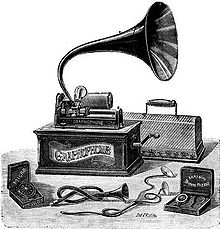Graphophone

Le Graphophone est le nom et la marque déposée d'une version améliorée du phonographe. Il fut développé par Charles Sumner Tainter (1854—1940) au Volta Laboratory fondé par Alexander Graham Bell à Washington, D.C. Il est la première machine à dicter[1],[2],[3].
L'usage de la marque fut la propriété successive de la Volta Graphophone Company, puis de l'American Graphophone Company, de la North American Phonograph Company et enfin de la Columbia Phonograph Company (qui devient plus tard Columbia Records), qui toutes produisirent ou vendirent des Graphophones.
Notes et références[modifier | modifier le code]
- Newville, Leslie J. Development Of The Phonograph At Alexander Graham Bell's Volta Laboratory, United States National Museum Bulletin, United States National Museum and the Museum of History and Technology, Washington, D.C., 1959, No. 218, Paper 5, p. 69-79. Retrieved from Gutenberg.org.
- Tainter, Charles Sumner. Recording Technology History: Charles Sumner Tainter Home Notes, History Department of, University of San Diego. Retrieved from University of San Diego History Department website December 19, 2009
- (en) « Audio Engineering Society : The Graphophone » (consulté le ).
